Catalytic Performance of Iron-Based Oxygen Carriers Mixed with Converter Steel Slags for Hydrogen Production in Chemical Looping Gasification of Brewers’ Spent Grains
Abstract
1. Introduction
2. Experimental Section
2.1. Materials
2.2. Experimental Apparatus and Methods
2.3. Data Evaluation
3. Chemical Reactions Involved
4. Results and Discussion
4.1. Effects of Temperature
4.2. Effects of OC/SG Ratio
4.3. Effects of Steam Flow Rate
4.4. Effects of the Weight Ratio of CSSs in CSS/Fe2O3 Composite OCs
4.5. Analysis and Characterization of CSS/Fe2O3 Composite OCs
4.6. Chemical Reactivity of CSS/Fe2O3 Composite OCs
4.7. Effects of Cycle Number
4.8. Performance Comparison of CSS/Fe2O3 Composite OCs and Other OCs
5. Conclusions
Author Contributions
Funding
Data Availability Statement
Conflicts of Interest
References
- Xie, Z.; Dan, M.; Zhao, G. Recent advances in microbial high-value utilization of brewer’s spent grain. Bioresour. Technol. 2024, 408, 131197. [Google Scholar] [CrossRef]
- Wang, Z.; Li, J.; Li, Z. A coupling strategy for comprehensive utilization of distillers’ grains towards energy recovery and carbon sequestration. Energy Convers. Manag. 2023, 275, 116494. [Google Scholar] [CrossRef]
- Ferreira, S.; Monteiro, E.; Calado, L.; Silva, V.; Brito, P.; Vilarinho, C. Experimental and modeling analysis of brewers’ spent grains gasification in a downdraft reactor. Energies 2019, 12, 4413. [Google Scholar] [CrossRef]
- Mussatto, S.I.; Dragone, G.; Roberto, I.C. Brewers’ spent grain: Generation, characteristics and potential applications. J. Cereal Sci. 2006, 43, 1–14. [Google Scholar] [CrossRef]
- Dieringer, P.; Marx, F.; Ströhle, J.; Epple, B. System hydrodynamics of a 1 MWth dual circulating fluidized bed chemical looping gasifier. Energies 2023, 16, 5630. [Google Scholar] [CrossRef]
- Qiu, Y.; Zeng, D.; Xiao, R. Hydrogen production from biomass-based chemical looping: A critical review and perspectives. Energy Fuels 2024, 38, 13819–13836. [Google Scholar] [CrossRef]
- Ponzio, A.; Kalisz, S.; Blasiak, W. Effect of operating conditions on tar and gas composition in high temperature air/steam gasification (HTAG) of plastic containing waste. Fuel Process. Technol. 2006, 87, 223–233. [Google Scholar] [CrossRef]
- Luo, M.; Yi, Y.; Wang, S. Review of hydrogen production using chemical-looping technology. Renew. Sustain. Energy Rev. 2018, 81, 3186–3214. [Google Scholar] [CrossRef]
- Huang, Z.; He, F.; Zhu, H. Thermodynamic analysis and thermogravimetric investigation on chemical looping gasification of biomass char under different atmospheres with Fe2O3 oxygen carrier. Appl. Energy 2015, 157, 546–553. [Google Scholar] [CrossRef]
- Hu, J.; Li, C.; Zhang, Q. Using chemical looping gasification with Fe2O3/Al2O3 oxygen carrier to produce syngas (H2+CO) from rice straw. Int. J. Hydrog. Energy 2019, 44, 3382–3386. [Google Scholar] [CrossRef]
- Huang, Z.; Zhang, Y.; Fu, J. Chemical looping gasification of biomass char using iron ore as an oxygen carrier. Int. J. Hydrogen Energy 2016, 41, 17871–17883. [Google Scholar] [CrossRef]
- Hu, Z.; Jiang, E.; Ma, X. The effect of oxygen carrier content and temperature on chemical looping gasification of microalgae for syngas production. J. Energy Inst. 2019, 92, 474–487. [Google Scholar] [CrossRef]
- Wu, Z.; Zhang, B.; Wu, S. Chemical looping gasification of lignocellulosic biomass with iron-based oxygen carrier: Products distribution and kinetic analysis on gaseous products from cellulose. Fuel Process. Technol. 2019, 193, 361–371. [Google Scholar] [CrossRef]
- Wang, L.; Feng, X.; Shen, L. Carbon and sulfur conversion of petroleum coke in the chemical looping gasification process. Energy 2019, 179, 1205–1216. [Google Scholar] [CrossRef]
- Niu, X.; Shen, L. Ca- and Mg-rich waste as high active carrier for chemical looping gasification of biomass. Chin. J. Chem. Eng. 2021, 38, 145–154. [Google Scholar] [CrossRef]
- Mayer, F.; Bidwe, A.R.; Schope, A. Comparison of a new micaceous iron oxide and ilmenite as oxygen carrier for Chemical looping combustion with respect to syngas conversion. Appl. Energy 2014, 113, 1863–1868. [Google Scholar] [CrossRef]
- Song, T.; Wu, J.; Zhang, H. Characterization of an Australia hematite oxygen carrier in chemical looping combustion with coal. Int. J. Greenh. Gas Control 2012, 11, 326–336. [Google Scholar] [CrossRef]
- Bao, J.; Li, Z.; Cai, N. Reduction Kinetics of Foreign-Ion-Promoted Ilmenite Using Carbon Monoxide (CO) for Chemical Looping Combustion. Ind. Eng. Chem. Res. 2013, 52, 10646–10655. [Google Scholar] [CrossRef]
- Huang, W.C.; Kuo, Y.L.; Su, Y.M. A facile method for sodium-modified Fe2O3/Al2O3 oxygen carrier by an air atmospheric pressure plasma jet for chemical looping combustion process. Chem. Eng. J. 2017, 316, 15–23. [Google Scholar] [CrossRef]
- Zhong, H.; Er, D.; Wen, L. Theoretical study on influence of CaO and MgO on the reduction of FeO by CO. Appl. Surf. Sci. 2017, 399, 630–637. [Google Scholar] [CrossRef]
- Hildor, F.; Leion, H.; Linderholm, C.J. Steel converter slag as an oxygen carrier for chemical-looping gasification. Fuel Process. Technol. 2020, 210, 106576. [Google Scholar] [CrossRef]
- Di, Z.; Cao, Y.; Yang, F. Studies on steel slag as an oxygen carrier for chemical looping combustion. Fuel 2018, 226, 618–626. [Google Scholar] [CrossRef]
- Nguyen, N.M.; Alobaid, F.; Epple, B. Chemical looping gasification of torrefied woodchips in a bubbling fluidized bed test rig using iron-based oxygen carriers. Renew. Energy 2021, 172, 34–45. [Google Scholar] [CrossRef]
- Huang, X.; Wu, J.; Wang, M.; Ma, X.; Jiang, E.; Hu, Z. Syngas production by chemical looping gasification of rice husk using Fe-based oxygen carrier. J. Energy Inst. 2020, 93, 1261–1270. [Google Scholar] [CrossRef]
- Luo, M.; Zhang, H.; Wang, S. Syngas production by chemical looping co-gasification of rice husk and coal using an iron-based oxygen carrier. Fuel 2022, 309, 122100. [Google Scholar] [CrossRef]
- Liu, Q.; Hu, C.; Peng, B. High H2/CO ratio syngas production from chemical looping co-gasification of biomass and poly-ethylene with CaO/Fe2O3 oxygen carrier. Energy Convers. Manag. 2019, 199, 111951. [Google Scholar] [CrossRef]
- Sun, Z.; Chen, Z.; Toan, S. Chemical looping deoxygenated gasification: An implication for efficient biomass utilization with high-quality syngas modulation and CO2 reduction. Energy Convers. Manag. 2020, 215, 112913. [Google Scholar] [CrossRef]
- Wei, G.; He, F.; Zhao, Z. Performance of Fe–Ni bimetallic oxygen carriers for chemical looping gasification of biomass in a 10 kWth interconnected circulating fluidized bed reactor. Int. J. Hydrogen Energy 2015, 40, 16021–16032. [Google Scholar] [CrossRef]
- Zhang, Z.; Wang, X.; Zhang, L. Characteristics of steel slag as an oxygen carrier for chemical looping gasification of sewage sludge. Energy 2022, 247, 123534. [Google Scholar] [CrossRef]
- Pan, Q.; Ma, L.; Du, W. Hydrogen-enriched syngas production by lignite chemical looping gasification with composite oxygen carriers of phosphogypsum and steel slag. Energy 2022, 241, 122927. [Google Scholar] [CrossRef]
- Wang, B.; Ma, Z.; Li, S.; Dai, J.; Patrascu, M.; Gao, X. Experiment investigation and multiscale modeling of biomass oxidative fast pyrolysis in a fluidized bed reactor. Chem. Eng. J. 2024, 501, 157546. [Google Scholar] [CrossRef]
- Zhang, J.; Wang, M.; Xu, S.; Feng, Y. Hydrogen and methane mixture from biomass gasification coupled with catalytic tar reforming, methanation and adsorption enhanced reforming. Fuel Process. Technol. 2019, 192, 147–153. [Google Scholar] [CrossRef]
- Hildor, F.; Soleimanisalim, A.H.; Seemann, M.; Mattisson, T.; Leion, H. Tar characteristics generated from a 10 kWth chemical-looping biomass gasifier using steel converter slag as an oxygen carrier. Fuel 2023, 331, 125770. [Google Scholar] [CrossRef]
- Kuttin, K.W.; Leghari, A.; Yu, H.; Xia, Z.; Ding, L.; Yu, G. Carbon dioxide-steam reforming gasification of carbonized bio-mass pellet for high syngas yield and TAR reduction through CFD modeling. Chem. Eng. Sci. 2024, 287, 119716. [Google Scholar] [CrossRef]
- Abdalazeez, A.; Li, T.; Cao, Y.; Wang, W.; Abuelgasim, S.; Liu, C. Syngas production from chemical looping gasification of rice husk-derived biochar over iron-based oxygen carriers modified by different alkaline earth metals. Int. J. Hydrogen Energy 2022, 47, 40881–40894. [Google Scholar] [CrossRef]
- Zhang, Z.; Zhang, Y.; Liu, L. Role and mechanism of calcium-based catalysts for methane dry reforming: A review. Fuel 2024, 355, 129329. [Google Scholar] [CrossRef]
- Shah, M.; Mesfer, M.K.A.; Danish, M. Design and optimization of Ni–Fe–La based catalytic system for CO2 utilization for sustainable syngas production via dry reforming of methane. J. Energy Inst. 2023, 110, 101346. [Google Scholar] [CrossRef]
- Zhang, H.; Sun, Z.; Hu, Y.H. Steam reforming of methane: Current states of catalyst design and process upgrading. Renew. Sustain. Energy Rev. 2021, 149, 111330. [Google Scholar] [CrossRef]
- Nguyen, D.L.T.; Tran, A.V.; Vo, D.N. Methane dry reforming: A catalyst challenge awaits. J. Ind. Eng. Chem. 2024, 140, 169–189. [Google Scholar] [CrossRef]
- Abdalazeez, A.; Wang, W.; Abuelgasim, S. Syngas production from chemical looping reforming of ethanol over iron-based oxygen carriers: Theoretical analysis and experimental investigation. Chin. J. Chem. Eng. 2021, 38, 123–131. [Google Scholar] [CrossRef]
- Lin, Y.; Wang, H.; Huang, Z. Chemical looping gasification coupled with steam reforming of biomass using NiFe2O4: Kinetic analysis of DAEM-TI, thermodynamic simulation of OC redox, and a loop test. Chem. Eng. J. 2020, 395, 125046. [Google Scholar] [CrossRef]
- Shen, X.; Yan, F.; Zhang, Z. Enhanced and environment-friendly chemical looping gasification of crop straw using red mud as a sinter-resistant oxygen carrier. Waste Manag. 2021, 121, 354–364. [Google Scholar] [CrossRef]
- Wu, Y.; Liao, Y.; Liu, G. Syngas production by chemical looping gasification of biomass with steam and CaO additive. Int. J. Hydrogen Energy 2018, 43, 19375–19383. [Google Scholar] [CrossRef]
- Liu, G.; Liao, Y.; Wu, Y. Synthesis gas production from microalgae gasification in the presence of Fe2O3 oxygen carrier and CaO additive. Appl. Energy 2018, 212, 955–965. [Google Scholar] [CrossRef]
- Leion, H.; Jerndal, E.; Steenari, B.M. Solid fuels in chemical-looping combustion using oxide scale and unprocessed iron ore as oxygen carriers. Fuel 2009, 88, 1945–1954. [Google Scholar] [CrossRef]
- Xu, L.; Wang, L.; Li, Y.; Song, Q.; Tian, Z.; Wang, C.; Zhao, M.; Gao, N. A novel high-entropy spinel ferrites (CoNiCuZnMg)Fe2O4 catalyst for H2 production via steam reforming of derived volatiles from polypropylene and waste cooking oil. Chem. Eng. J. 2024, 488, 150767. [Google Scholar] [CrossRef]
- Das, S.; Biswas, A.; Tiwary, C.S.; Paliwal, M. Hydrogen production using chemical looping technology: A review with emphasis on H2 yield of various oxygen carriers. Int. J. Hydrogen Energy 2022, 47, 28322–28352. [Google Scholar] [CrossRef]
- Chen, J.; Zhao, K.; Zhao, Z.; He, F.; Huang, Z.; Wei, G. Identifying the roles of MFe2O4 (M=Cu, Ba, Ni, and Co) in the chemical looping reforming of char, pyrolysis gas and tar resulting from biomass pyrolysis. Int. J. Hydrogen Energy 2019, 44, 4674–4687. [Google Scholar] [CrossRef]
- Chen, J.; Wang, X.; Gai, D.; Wang, J. B-site semi-doped LaFeO3 perovskite oxygen carrier for biomass chemical looping steam gasification to produce hydrogen-rich syngas. Int. J. Hydrogen Energy 2025, 103, 446–455. [Google Scholar] [CrossRef]
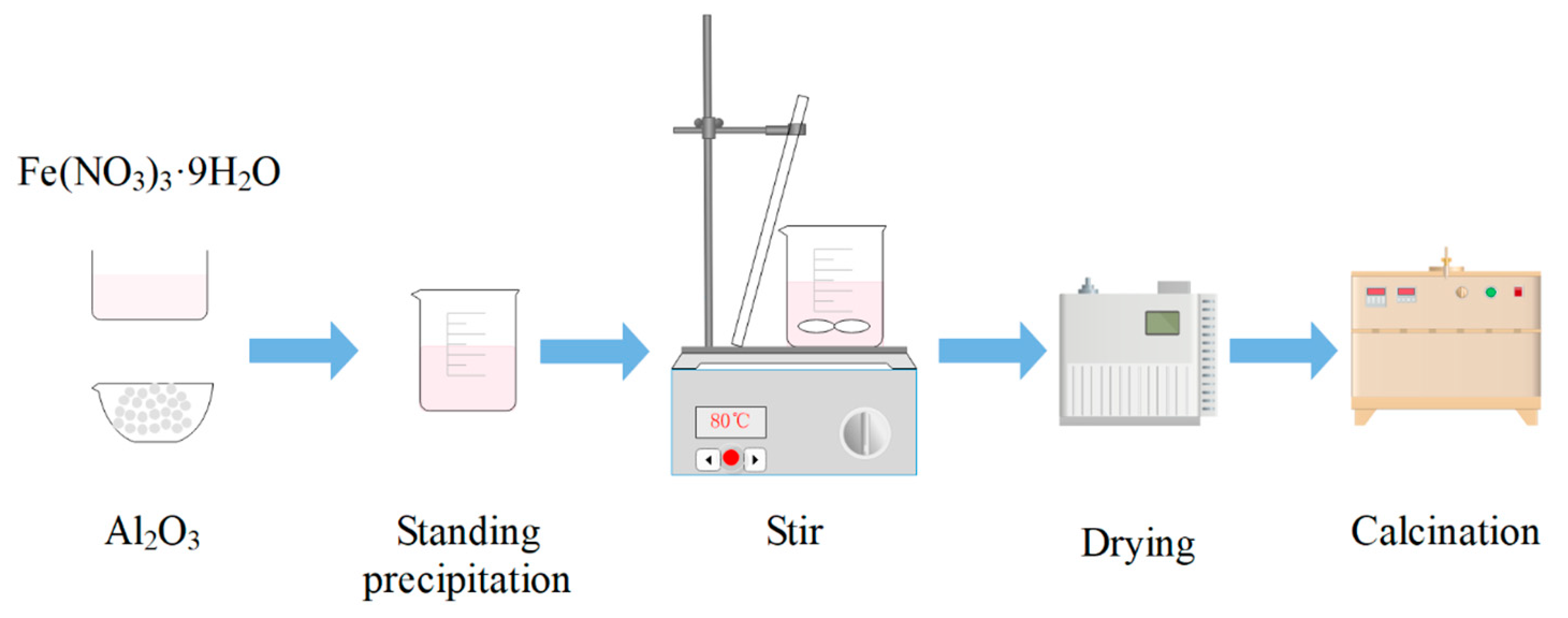
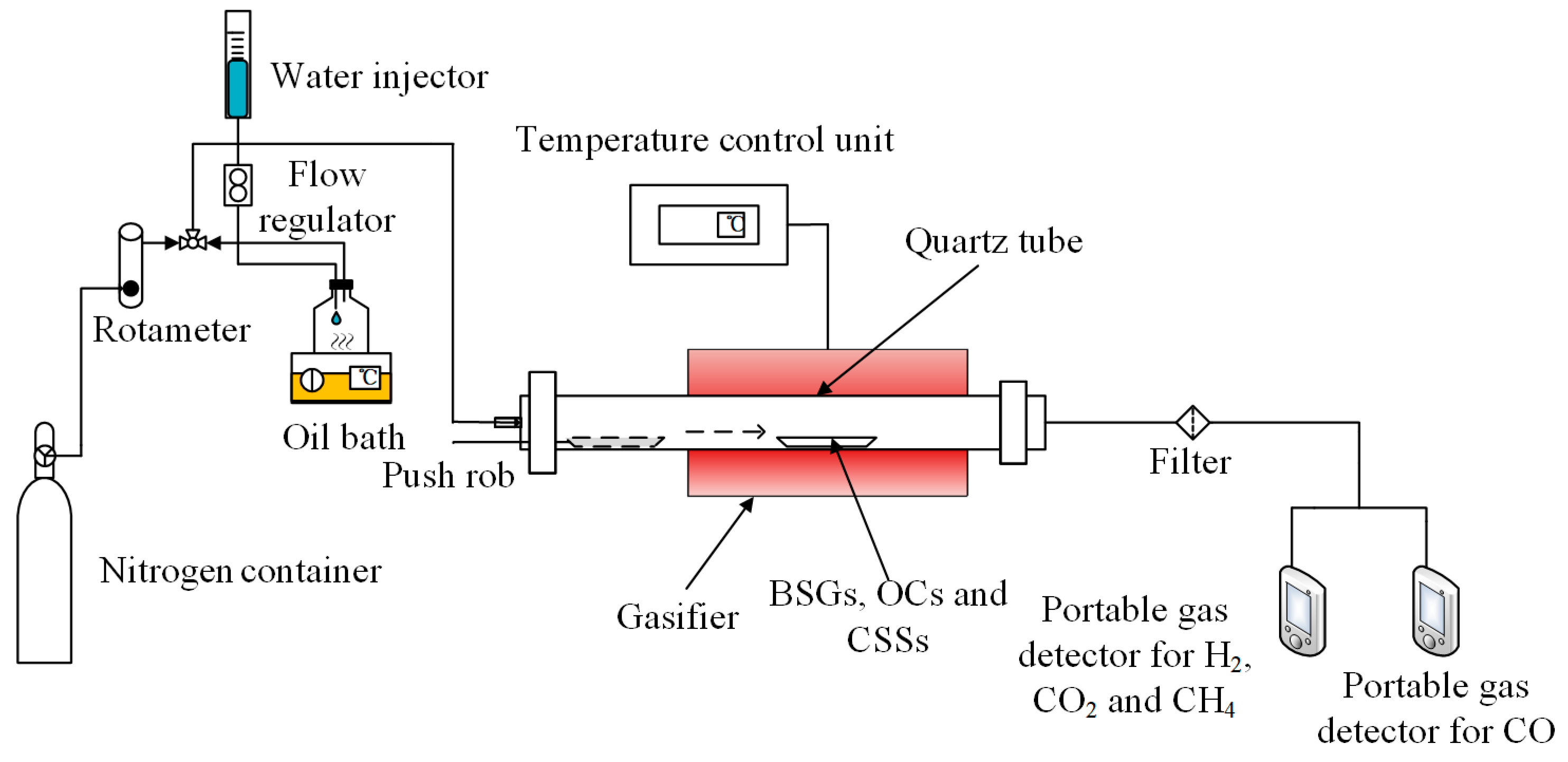



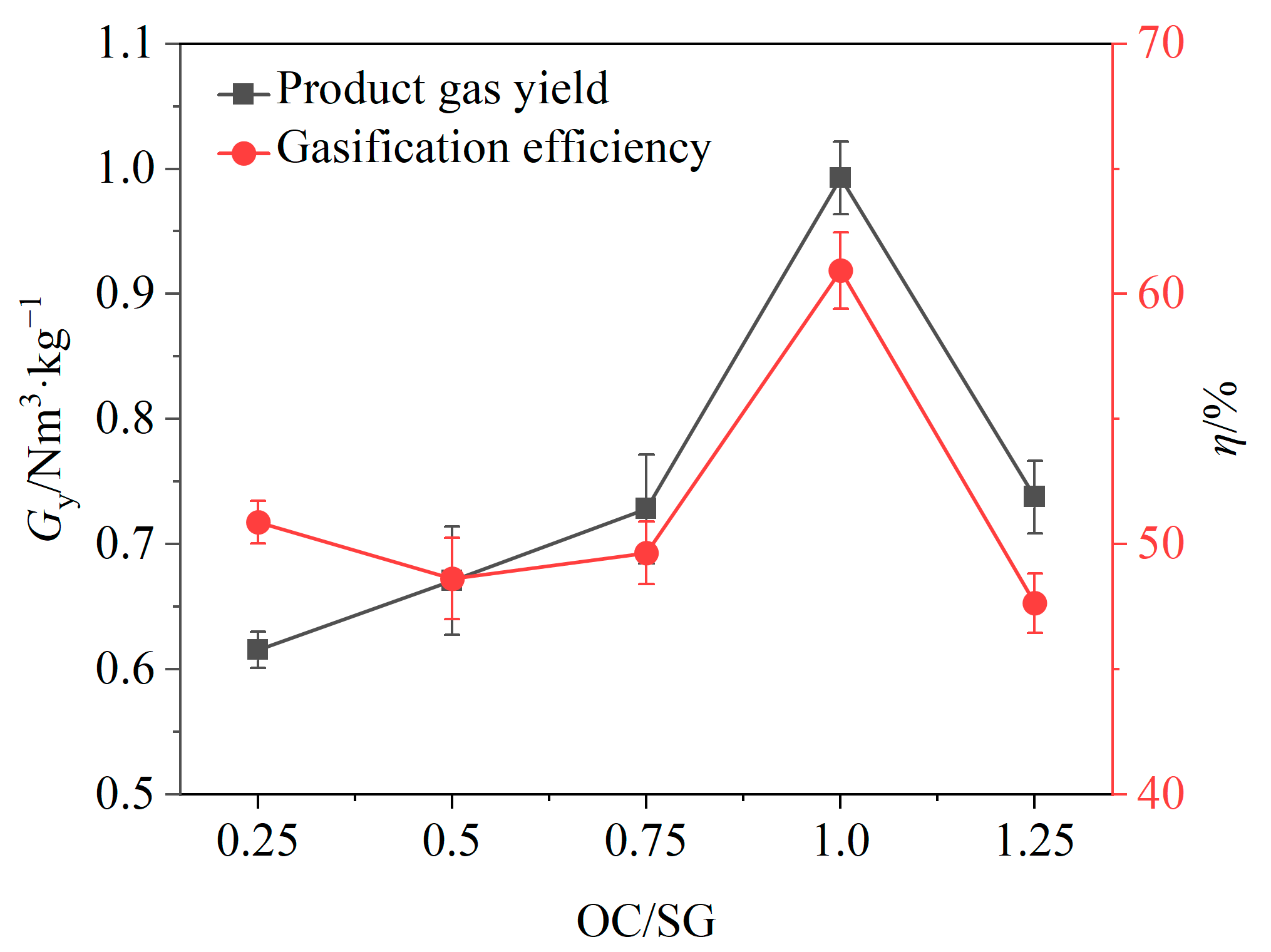




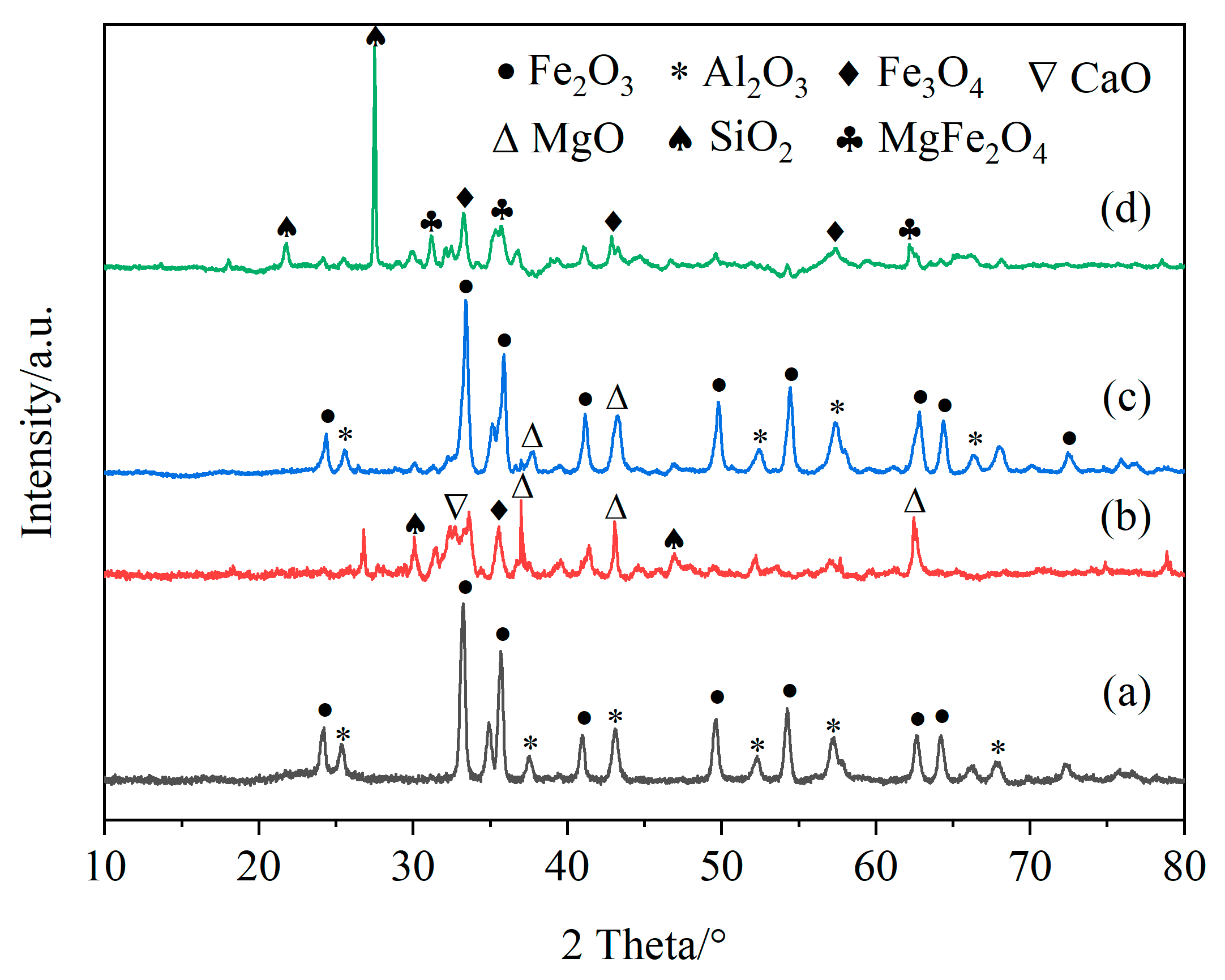
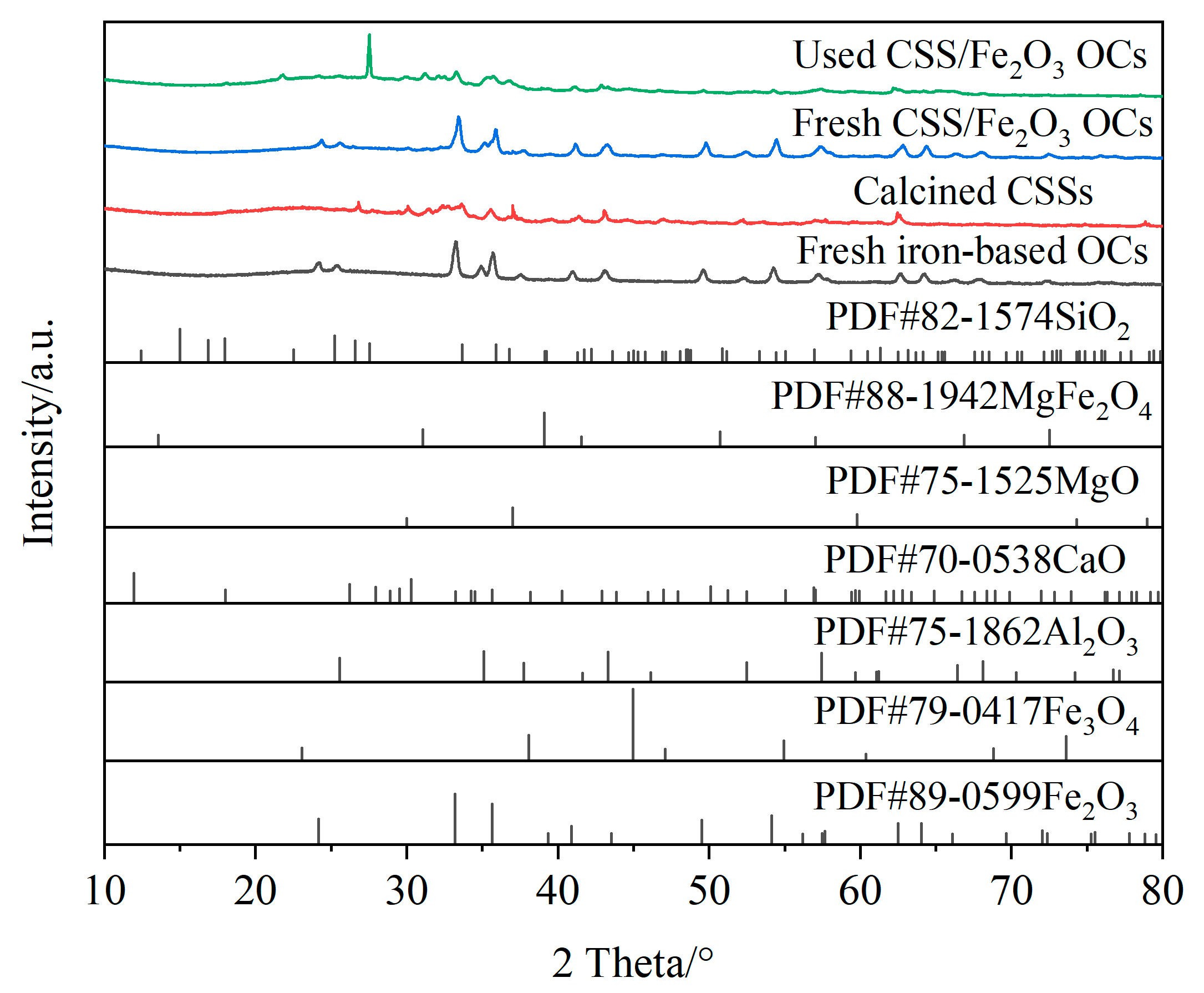
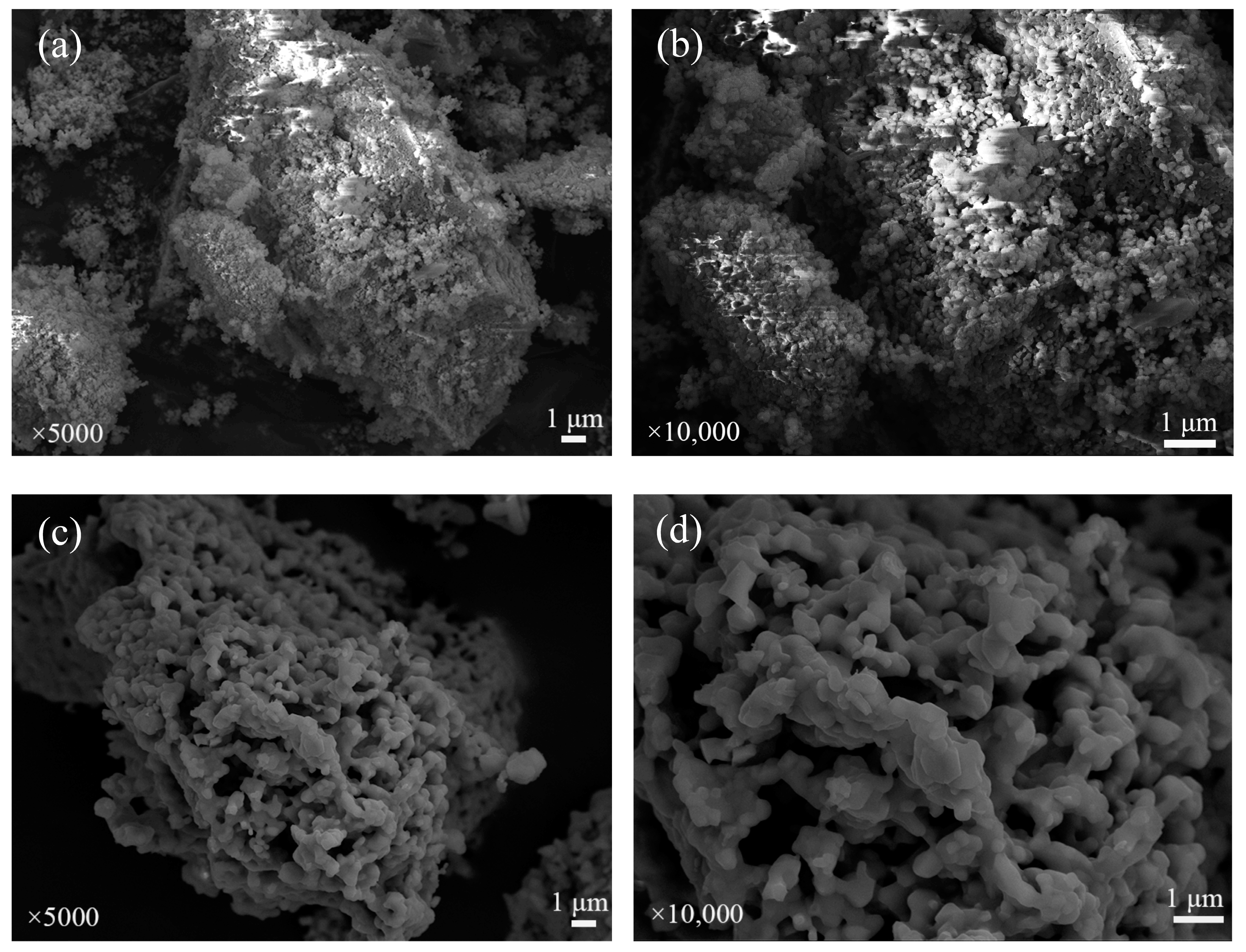
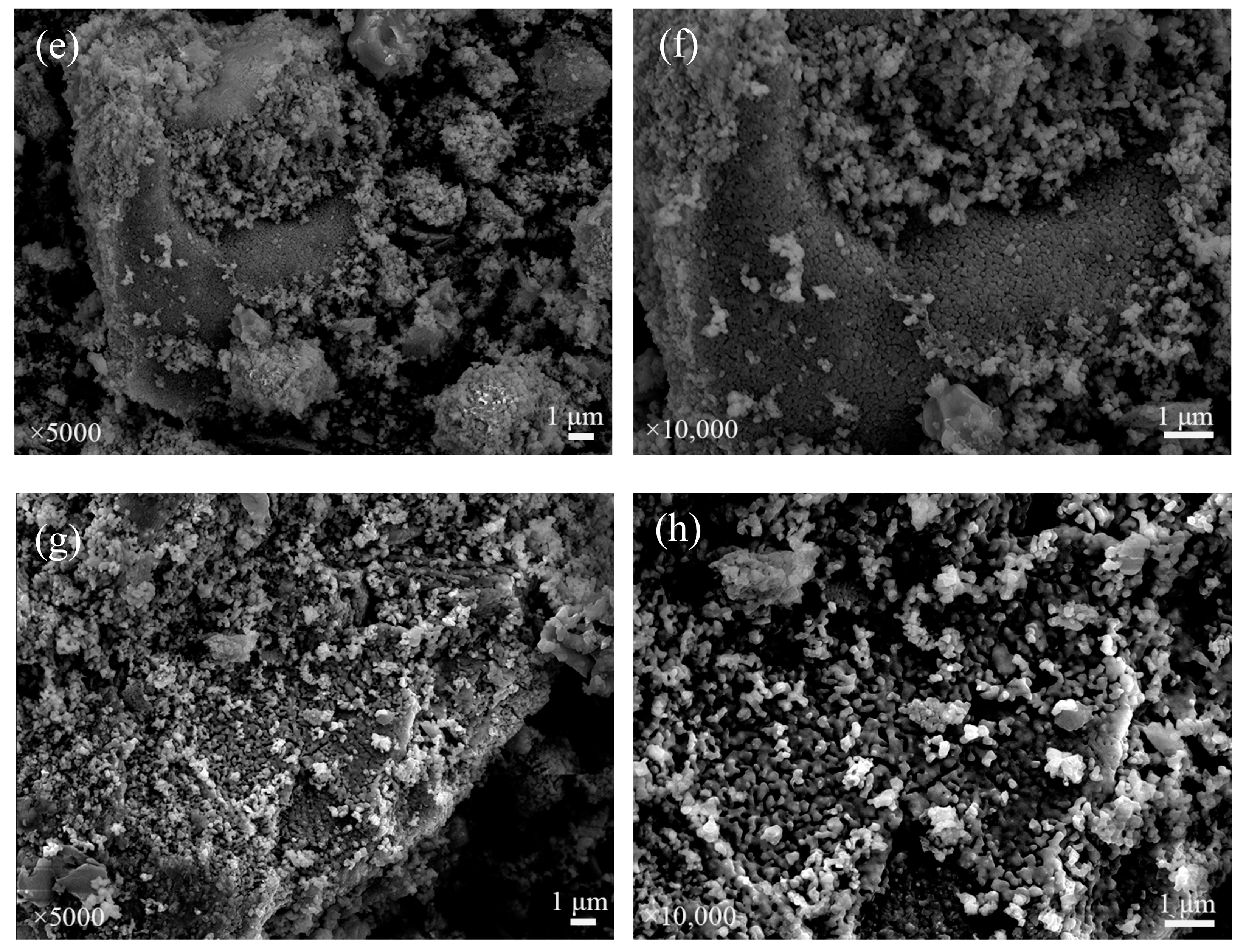
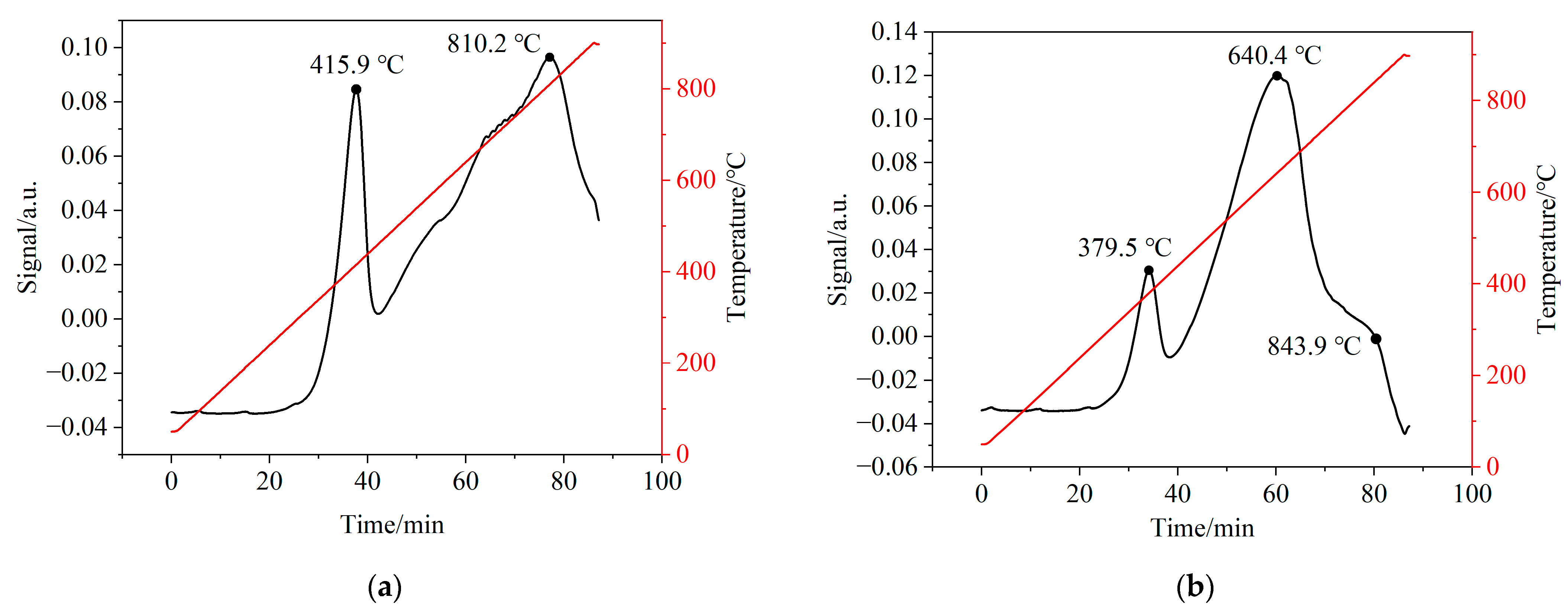

| Proximate Analysis (Air-Dry Basis %) | Ultimate Analysis (Dry Basis %) | Qad,net (kJ·kg−1) | |||||||
|---|---|---|---|---|---|---|---|---|---|
| Mad | FCad | Vad | Aad | Cd | Hd | Od * | Nd | Sd | |
| 10.16 | 14.48 | 65.14 | 10.22 | 40.08 | 5.65 | 38.54 | 4.15 | 0.20 | 13,455 |
| Composition | Fe2O3 | CaO | SiO2 | Al2O3 | MnO | MgO | P2O5 | TiO2 |
|---|---|---|---|---|---|---|---|---|
| Mass percent (wt%) | 20.185 | 28.04 | 18.462 | 9.081 | 3.246 | 15.567 | 1.283 | 1.164 |
| Compositions | SiO2 | CaO | K2O | P2O5 | Al2O3 | MgO | Fe2O3 | SO3 | Na2O | TiO2 |
|---|---|---|---|---|---|---|---|---|---|---|
| Mass percent (wt%) | 50.84 | 4.49 | 10.14 | 16.45 | 2.40 | 5.47 | 2.02 | 1.03 | 6.52 | 0.16 |
| Performance Metric | CSS/Fe2O3 Composite OCs | Iron-Based OCs | Perovskites OCs |
|---|---|---|---|
| Relative volume fraction of Hydrogen (%) | 30−50 | 10−20 | 40−50 |
| Gasification Efficiency (%) | 45−65 | 30−50 | 80−90 |
| Cyclic stability | Moderate | Excellent | Excellent |
| Cost | Low | Low | High |
| Advantages | High hydrogen yield and low cost | The most common, low-cost and environmentally friendly | High stability, multifunctional |
| Limitations | Moderate cyclic stability | The hydrogen yield is relatively low | Complex synthesis |
Disclaimer/Publisher’s Note: The statements, opinions and data contained in all publications are solely those of the individual author(s) and contributor(s) and not of MDPI and/or the editor(s). MDPI and/or the editor(s) disclaim responsibility for any injury to people or property resulting from any ideas, methods, instructions or products referred to in the content. |
© 2025 by the authors. Licensee MDPI, Basel, Switzerland. This article is an open access article distributed under the terms and conditions of the Creative Commons Attribution (CC BY) license (https://creativecommons.org/licenses/by/4.0/).
Share and Cite
Yuan, M.; Jiang, H.; Zuo, X.; Wang, C.; Li, Y.; Yang, H. Catalytic Performance of Iron-Based Oxygen Carriers Mixed with Converter Steel Slags for Hydrogen Production in Chemical Looping Gasification of Brewers’ Spent Grains. Energies 2025, 18, 1298. https://doi.org/10.3390/en18051298
Yuan M, Jiang H, Zuo X, Wang C, Li Y, Yang H. Catalytic Performance of Iron-Based Oxygen Carriers Mixed with Converter Steel Slags for Hydrogen Production in Chemical Looping Gasification of Brewers’ Spent Grains. Energies. 2025; 18(5):1298. https://doi.org/10.3390/en18051298
Chicago/Turabian StyleYuan, Miao, Huawei Jiang, Xiangli Zuo, Cuiping Wang, Yanhui Li, and Hairui Yang. 2025. "Catalytic Performance of Iron-Based Oxygen Carriers Mixed with Converter Steel Slags for Hydrogen Production in Chemical Looping Gasification of Brewers’ Spent Grains" Energies 18, no. 5: 1298. https://doi.org/10.3390/en18051298
APA StyleYuan, M., Jiang, H., Zuo, X., Wang, C., Li, Y., & Yang, H. (2025). Catalytic Performance of Iron-Based Oxygen Carriers Mixed with Converter Steel Slags for Hydrogen Production in Chemical Looping Gasification of Brewers’ Spent Grains. Energies, 18(5), 1298. https://doi.org/10.3390/en18051298






